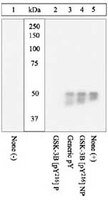ST1013 Sigma-AldrichPhosphoDetect™ Anti-GSK-3α/β (pTyr279/216) Rabbit pAb
This PhosphoDetect™ Anti-GSK-3α/β Rabbit pAb is validated for use in Dot Blot, ELISA, WB, ICC for the detection of GSK-3α/β.
More>> This PhosphoDetect™ Anti-GSK-3α/β Rabbit pAb is validated for use in Dot Blot, ELISA, WB, ICC for the detection of GSK-3α/β. Less<<Synonyms: Anti-Glycogen Synthase Kinase-3α/β, Phospho-Specific (Tyr279/216)
Recommended Products
Overview
| Replacement Information |
|---|
Key Specifications Table
| Species Reactivity | Host | Antibody Type |
|---|---|---|
| H, M, R | Rb | Polyclonal Antibody |
Products
| Catalog Number | Packaging | Qty/Pack | |
|---|---|---|---|
| ST1013-10T | Plastic ampoule | 10 t |
| References | |
|---|---|
| References | Papasozomenos, S.C., et al. 2002. PNAS 99, 1140. Kirschenbaum, F., et al. 2001. J. Biol. Chem. 276, 7366. Bhat, R.V., et al. 2000. Proc. Natl. Acad. Sci. USA 97, 11074. |
| Product Information | |
|---|---|
| Form | Liquid |
| Formulation | In Dulbecco's PBS (without Mg2+ and Ca2+), 50% glycerol, 1 mg/ml BSA, pH 7.3. |
| Negative control | Normal rabbit serum |
| Positive control | Serum starved insulin-treated 3T3-L1 cells |
| Preservative | ≤0.1% sodium azide |
| Quality Level | MQ100 |
| Physicochemical Information |
|---|
| Dimensions |
|---|
| Materials Information |
|---|
| Toxicological Information |
|---|
| Safety Information according to GHS |
|---|
| Safety Information |
|---|
| Product Usage Statements |
|---|
| Packaging Information |
|---|
| Transport Information |
|---|
| Supplemental Information |
|---|
| Specifications |
|---|
| Global Trade Item Number | |
|---|---|
| Catalog Number | GTIN |
| ST1013-10T | 04055977208665 |
Documentation
PhosphoDetect™ Anti-GSK-3α/β (pTyr279/216) Rabbit pAb Certificates of Analysis
| Title | Lot Number |
|---|---|
| ST1013 |
References
| Reference overview |
|---|
| Papasozomenos, S.C., et al. 2002. PNAS 99, 1140. Kirschenbaum, F., et al. 2001. J. Biol. Chem. 276, 7366. Bhat, R.V., et al. 2000. Proc. Natl. Acad. Sci. USA 97, 11074. |








